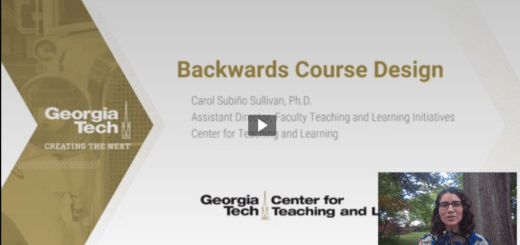Learning Myth Busters: Learning Styles

Imagine for a moment that you are my medical doctor and you asked me on my intake form, as my doctor once did, to report my preferred learning styles. My options: verbal, visual, or written. You come into the exam room to give me my diagnosis. How would you change the way you tell me about my illness and treatment based on my preferred learning style? And will your message delivery change for your next patient?
Learning styles have infiltrated all levels of education, as well as the general public’s understanding of learning, bolstered by a thriving industry of assessment tools promising to help students, teachers, and parents improve learning through better understanding of students’ learning preferences. It sounds so promising! We can diagnose struggling students’ difficulties using a learning styles inventory and then prescribe study techniques and in-class content delivery strategies to fit learning to their style. Once we know that Damien is a visual learner, Damien benefits from diagrams and charts to understand new information. Chunmeng is an auditory learning? She’ll do better if she hears the information. And so we set out as educators, mixing in a variety of content delivery strategies to cover our bases and hit all of the possible learning styles in our classes.
So, what’s the problem? The problem is that learning styles don’t exist.
Let me clarify. If presented with an inventory exploring the ways we prefer to interact with the world around us, we can certainly state some preferences. Some of us do prefer visual imagery over auditory stimuli while others of us are drawn to activities that allow us to move our bodies as we explore our world. We know that students have different cognitive strengths; some excel at reading for deep meaning, while others manipulate numbers with ease. The idea that we are all unique flowers learners is appealing to students and reinforced through a psychological phenomenon called confirmation bias. Damien-the-visual-learner may be captivated by a trip to the museum but bored by a lecture in art history, which serves to reinforce his perception that he learns better through visual stimuli.
If matching learning styles to teaching styles resulted in better learning, a specific interaction effect would be observed. Visual learners would perform better when given visual instruction compared to verbal instruction and verbal learners would perform better when given verbal instruction compared to visual instruction. Paschler et al. (2008) demonstrates the potential interaction effects that would support learning styles theory in Figure 1. From a thorough literature review, Paschler and colleagues identified a handful of studies that failed to find this required interaction and only one study, with weak methodology, that supported the learning style matching theory. There simply is not enough evidence in support of learning styles theory to warrant its use as a teaching technique.
Figure 1.
Where did the theory come from and why does it continue?
As our understanding of human learning has advanced, theories of intelligence have evolved from a single “general” intelligence that could be measured on an IQ test, to theories of multiple intelligences. Beginning in the 1980s, Robert Sternberg devised his triarchic theory of intelligence, which recognized that different tasks and different contexts would require different types of thinking, and so proposed componential (analytical), experiential, and practical intelligences. Meanwhile, Howard Gardner’s theory of multiple intelligences identified 8 distinct intelligences that represent individual strengths in areas such as spatial, musical, intrapersonal, and naturalistic. Neither of these theories offer corresponding assessment tools; Gardner himself noted that humans have limited insight into their own preferences and struggle to distinguish between preferences, interests, and cognitive skill. Indeed, Massa and Mayer (2006) found only a weak relationship between self-reported preference for visual versus verbal information and specific visual or verbal aptitude measured through objective testing.
Sometimes students and teachers attest to “anecdata” evidence in support of learning styles. If a teacher includes both verbal and visual stimuli in the hopes of satisfying multiple learning styles, she may be observing the benefits of what psychologists call dual encoding. All of our brains perceive new information through our five senses; hitting more than one sense at a time creates a more robust perceptual experience. For example, our early childhood memories are often rich with sights, sounds, smells, and tastes – Dad’s pipe smoke, Grandma’s apple pie, your first bloody nose. When we integrate multiple modes of content delivery, learners benefit from this dual encoding to produce more stable memory, not because some of us prefer one type of stimuli to the other, but because all of us learn better with multiple stimuli.
What’s the harm?
If learning styles theories lead instructors to present information in multiple ways and ends up helping learners through dual encoding, then what harm do the theories do? First, by concentrating on matching teaching style to learning style, we are asking the wrong question. Instead of asking how we can teach to all learning styles, we should be asking which mode of delivery is best matched to our content.
Second, teaching to students’ learning styles strikes me as an odd pedagogical goal. If we know students will encounter information from a variety of stimuli outside the classroom, why would we want to enhance only their “preferred” learning style and ignore their least preferred styles? Likewise, when learning falters, which it does at times, the learning style theory gives learners an easy out – “that teacher doesn’t teach the way I prefer to learn.” The next generation of critical thinkers and innovators will need to function well in a dynamic environment where they can absorb information from a wide variety of sources.
Luckily for us, that’s exactly how (most of) our brains work; we’re wired to perceive information from a wide variety of sources. Certainly, we make meaning of our lived experience in unique ways. We interpret new information through the lens of our various expectations and we understand new information differently as we relate it to prior knowledge. Some students have cognitive processing differences that make some learning demands more challenging. Continuing to support learning styles theories distracts us from employing the multitude of other, evidence-based interventions that we should be using to help students learn.
What should we do instead?
Help interrupt the myth of learning styles. As you notice yourself and others using the term learning styles, you might note that there isn’t sufficient evidence to support continued promotion of this theory. We can honor the individual and personal experience of learning with terms like “learning differences” or “learner diversity” instead. Our students bring many individual differences with them into our classrooms – gender, race, ethnicity, religion, sexual orientation, gender identity, disability, mental health challenges, financial security, prior experience, mindset, goals, aspirations, motivation, and on and on. Any of these individual differences would be more useful to consider in our teaching than learning styles.
For more information on learning styles, I encourage you to review Reiner and Willingham (2010) and Pashler, McDaniel, Rohrer, and Bjork (2008).
Do you have a learning theory you’d like “busted”? Submit suggestions here for the next Learning Myth Busters installment.
References:
Pashler, H., McDaniel, M., Rohrer, D., & Bjork, R. (2008). Learning styles: Concepts and evidence. Psychological Science in the Public Interest, 9(3), 105-119.
Reiner, C. & Willingam, D. (2010). The myth of learning styles. Change: The Magazine of Higher Learning, 42, 32-35.





